Analyzing Entrepreneurial Ventures, Success Factors & Economic Impact
VerifiedAdded on 2024/05/21
|20
|5425
|404
Report
AI Summary
This report provides a detailed analysis of various types of entrepreneurial ventures, including small-profit, lifestyle, and high-growth ventures, and their relationship to different types of entrepreneurship. It explores the similarities and differences between these ventures, along with an examination of the impact of micro and small businesses on the UK economy, highlighting their contribution to employment and GDP. The report also discusses the importance of small and start-up businesses in the social economy and delves into the characteristics of successful entrepreneurs, assessing how their personality reflects entrepreneurial motivation and mindset. Furthermore, it investigates how a person's background and past experiences can influence their entrepreneurial journey, either positively or negatively, and analyzes the link between entrepreneurial characteristics and the influences of personal background and experience. The report concludes by summarizing the key factors that contribute to entrepreneurial success.

Understanding entrepreneurship
Paraphrase This Document
Need a fresh take? Get an instant paraphrase of this document with our AI Paraphraser
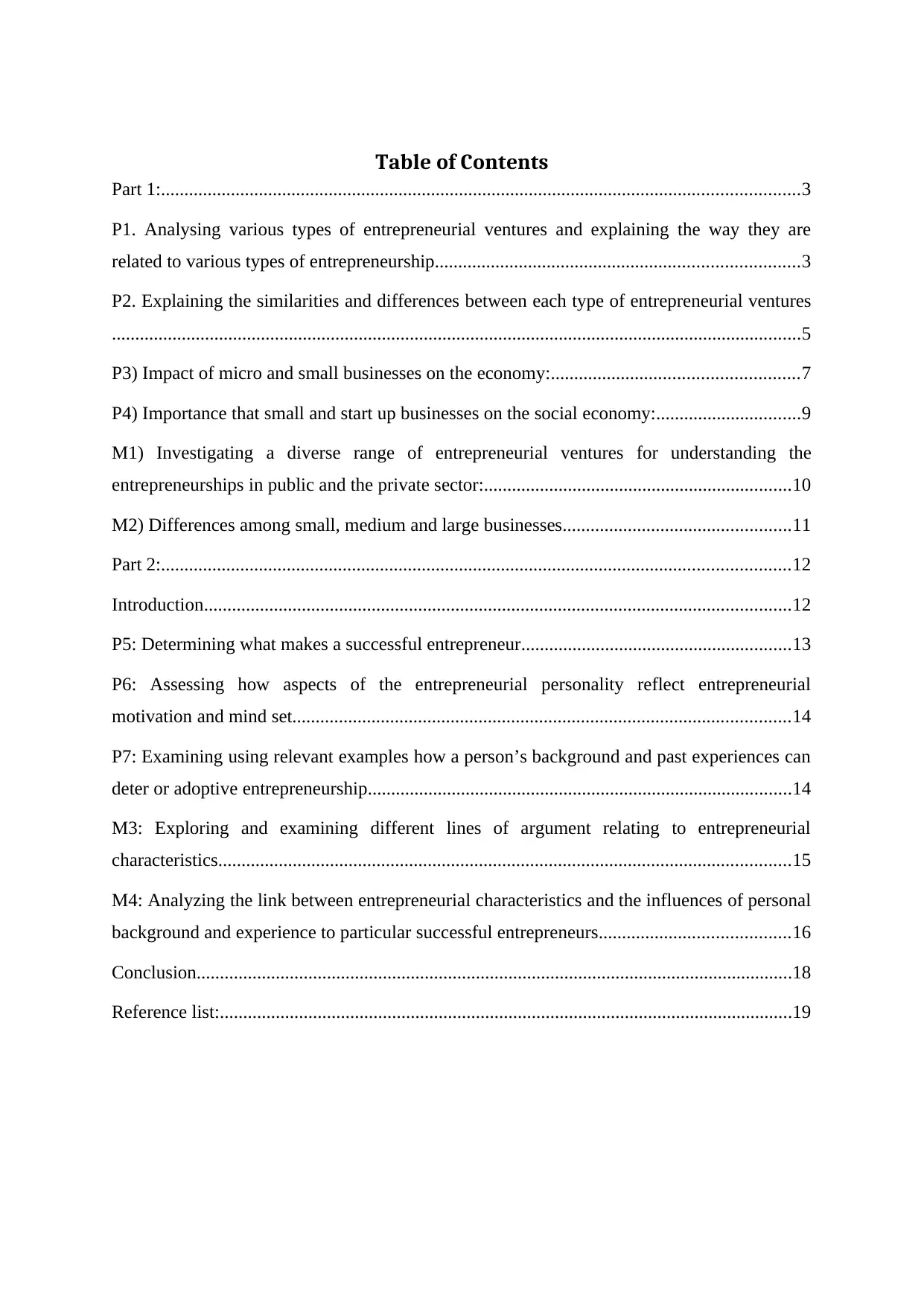
Table of Contents
Part 1:.........................................................................................................................................3
P1. Analysing various types of entrepreneurial ventures and explaining the way they are
related to various types of entrepreneurship..............................................................................3
P2. Explaining the similarities and differences between each type of entrepreneurial ventures
....................................................................................................................................................5
P3) Impact of micro and small businesses on the economy:.....................................................7
P4) Importance that small and start up businesses on the social economy:...............................9
M1) Investigating a diverse range of entrepreneurial ventures for understanding the
entrepreneurships in public and the private sector:..................................................................10
M2) Differences among small, medium and large businesses.................................................11
Part 2:.......................................................................................................................................12
Introduction..............................................................................................................................12
P5: Determining what makes a successful entrepreneur..........................................................13
P6: Assessing how aspects of the entrepreneurial personality reflect entrepreneurial
motivation and mind set...........................................................................................................14
P7: Examining using relevant examples how a person’s background and past experiences can
deter or adoptive entrepreneurship...........................................................................................14
M3: Exploring and examining different lines of argument relating to entrepreneurial
characteristics...........................................................................................................................15
M4: Analyzing the link between entrepreneurial characteristics and the influences of personal
background and experience to particular successful entrepreneurs.........................................16
Conclusion................................................................................................................................18
Reference list:...........................................................................................................................19
Part 1:.........................................................................................................................................3
P1. Analysing various types of entrepreneurial ventures and explaining the way they are
related to various types of entrepreneurship..............................................................................3
P2. Explaining the similarities and differences between each type of entrepreneurial ventures
....................................................................................................................................................5
P3) Impact of micro and small businesses on the economy:.....................................................7
P4) Importance that small and start up businesses on the social economy:...............................9
M1) Investigating a diverse range of entrepreneurial ventures for understanding the
entrepreneurships in public and the private sector:..................................................................10
M2) Differences among small, medium and large businesses.................................................11
Part 2:.......................................................................................................................................12
Introduction..............................................................................................................................12
P5: Determining what makes a successful entrepreneur..........................................................13
P6: Assessing how aspects of the entrepreneurial personality reflect entrepreneurial
motivation and mind set...........................................................................................................14
P7: Examining using relevant examples how a person’s background and past experiences can
deter or adoptive entrepreneurship...........................................................................................14
M3: Exploring and examining different lines of argument relating to entrepreneurial
characteristics...........................................................................................................................15
M4: Analyzing the link between entrepreneurial characteristics and the influences of personal
background and experience to particular successful entrepreneurs.........................................16
Conclusion................................................................................................................................18
Reference list:...........................................................................................................................19
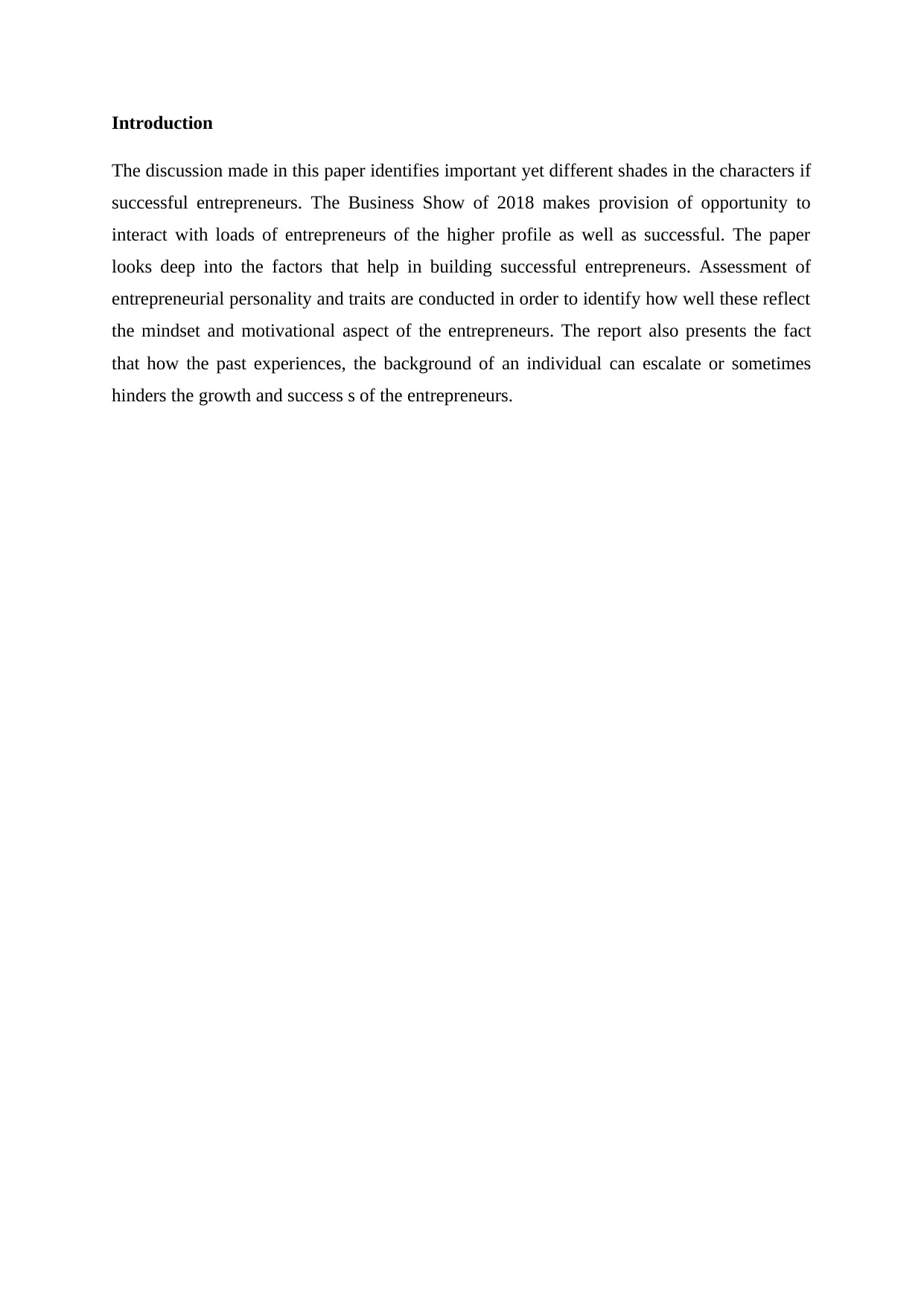
Introduction
The discussion made in this paper identifies important yet different shades in the characters if
successful entrepreneurs. The Business Show of 2018 makes provision of opportunity to
interact with loads of entrepreneurs of the higher profile as well as successful. The paper
looks deep into the factors that help in building successful entrepreneurs. Assessment of
entrepreneurial personality and traits are conducted in order to identify how well these reflect
the mindset and motivational aspect of the entrepreneurs. The report also presents the fact
that how the past experiences, the background of an individual can escalate or sometimes
hinders the growth and success s of the entrepreneurs.
The discussion made in this paper identifies important yet different shades in the characters if
successful entrepreneurs. The Business Show of 2018 makes provision of opportunity to
interact with loads of entrepreneurs of the higher profile as well as successful. The paper
looks deep into the factors that help in building successful entrepreneurs. Assessment of
entrepreneurial personality and traits are conducted in order to identify how well these reflect
the mindset and motivational aspect of the entrepreneurs. The report also presents the fact
that how the past experiences, the background of an individual can escalate or sometimes
hinders the growth and success s of the entrepreneurs.
⊘ This is a preview!⊘
Do you want full access?
Subscribe today to unlock all pages.

Trusted by 1+ million students worldwide
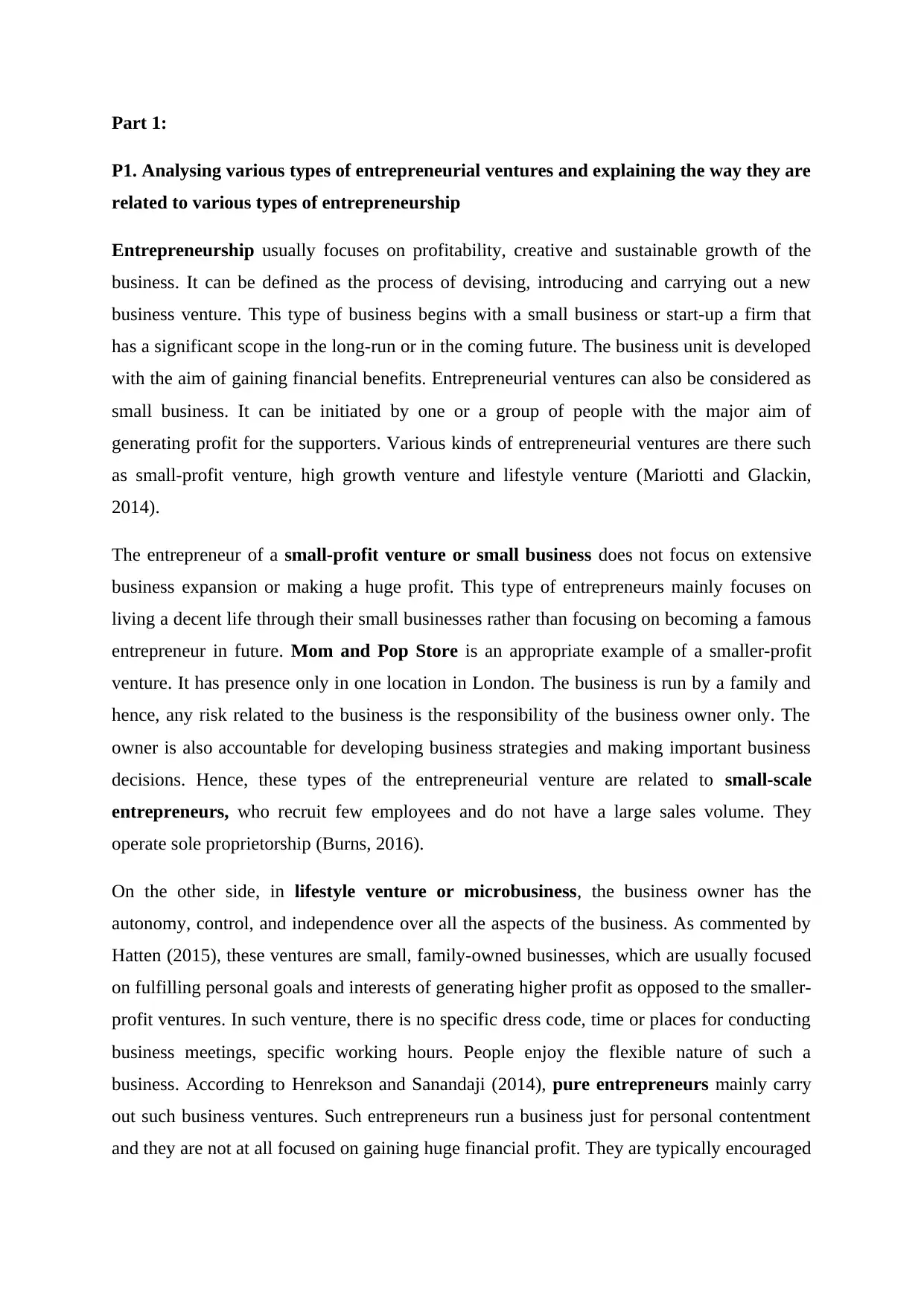
Part 1:
P1. Analysing various types of entrepreneurial ventures and explaining the way they are
related to various types of entrepreneurship
Entrepreneurship usually focuses on profitability, creative and sustainable growth of the
business. It can be defined as the process of devising, introducing and carrying out a new
business venture. This type of business begins with a small business or start-up a firm that
has a significant scope in the long-run or in the coming future. The business unit is developed
with the aim of gaining financial benefits. Entrepreneurial ventures can also be considered as
small business. It can be initiated by one or a group of people with the major aim of
generating profit for the supporters. Various kinds of entrepreneurial ventures are there such
as small-profit venture, high growth venture and lifestyle venture (Mariotti and Glackin,
2014).
The entrepreneur of a small-profit venture or small business does not focus on extensive
business expansion or making a huge profit. This type of entrepreneurs mainly focuses on
living a decent life through their small businesses rather than focusing on becoming a famous
entrepreneur in future. Mom and Pop Store is an appropriate example of a smaller-profit
venture. It has presence only in one location in London. The business is run by a family and
hence, any risk related to the business is the responsibility of the business owner only. The
owner is also accountable for developing business strategies and making important business
decisions. Hence, these types of the entrepreneurial venture are related to small-scale
entrepreneurs, who recruit few employees and do not have a large sales volume. They
operate sole proprietorship (Burns, 2016).
On the other side, in lifestyle venture or microbusiness, the business owner has the
autonomy, control, and independence over all the aspects of the business. As commented by
Hatten (2015), these ventures are small, family-owned businesses, which are usually focused
on fulfilling personal goals and interests of generating higher profit as opposed to the smaller-
profit ventures. In such venture, there is no specific dress code, time or places for conducting
business meetings, specific working hours. People enjoy the flexible nature of such a
business. According to Henrekson and Sanandaji (2014), pure entrepreneurs mainly carry
out such business ventures. Such entrepreneurs run a business just for personal contentment
and they are not at all focused on gaining huge financial profit. They are typically encouraged
P1. Analysing various types of entrepreneurial ventures and explaining the way they are
related to various types of entrepreneurship
Entrepreneurship usually focuses on profitability, creative and sustainable growth of the
business. It can be defined as the process of devising, introducing and carrying out a new
business venture. This type of business begins with a small business or start-up a firm that
has a significant scope in the long-run or in the coming future. The business unit is developed
with the aim of gaining financial benefits. Entrepreneurial ventures can also be considered as
small business. It can be initiated by one or a group of people with the major aim of
generating profit for the supporters. Various kinds of entrepreneurial ventures are there such
as small-profit venture, high growth venture and lifestyle venture (Mariotti and Glackin,
2014).
The entrepreneur of a small-profit venture or small business does not focus on extensive
business expansion or making a huge profit. This type of entrepreneurs mainly focuses on
living a decent life through their small businesses rather than focusing on becoming a famous
entrepreneur in future. Mom and Pop Store is an appropriate example of a smaller-profit
venture. It has presence only in one location in London. The business is run by a family and
hence, any risk related to the business is the responsibility of the business owner only. The
owner is also accountable for developing business strategies and making important business
decisions. Hence, these types of the entrepreneurial venture are related to small-scale
entrepreneurs, who recruit few employees and do not have a large sales volume. They
operate sole proprietorship (Burns, 2016).
On the other side, in lifestyle venture or microbusiness, the business owner has the
autonomy, control, and independence over all the aspects of the business. As commented by
Hatten (2015), these ventures are small, family-owned businesses, which are usually focused
on fulfilling personal goals and interests of generating higher profit as opposed to the smaller-
profit ventures. In such venture, there is no specific dress code, time or places for conducting
business meetings, specific working hours. People enjoy the flexible nature of such a
business. According to Henrekson and Sanandaji (2014), pure entrepreneurs mainly carry
out such business ventures. Such entrepreneurs run a business just for personal contentment
and they are not at all focused on gaining huge financial profit. They are typically encouraged
Paraphrase This Document
Need a fresh take? Get an instant paraphrase of this document with our AI Paraphraser
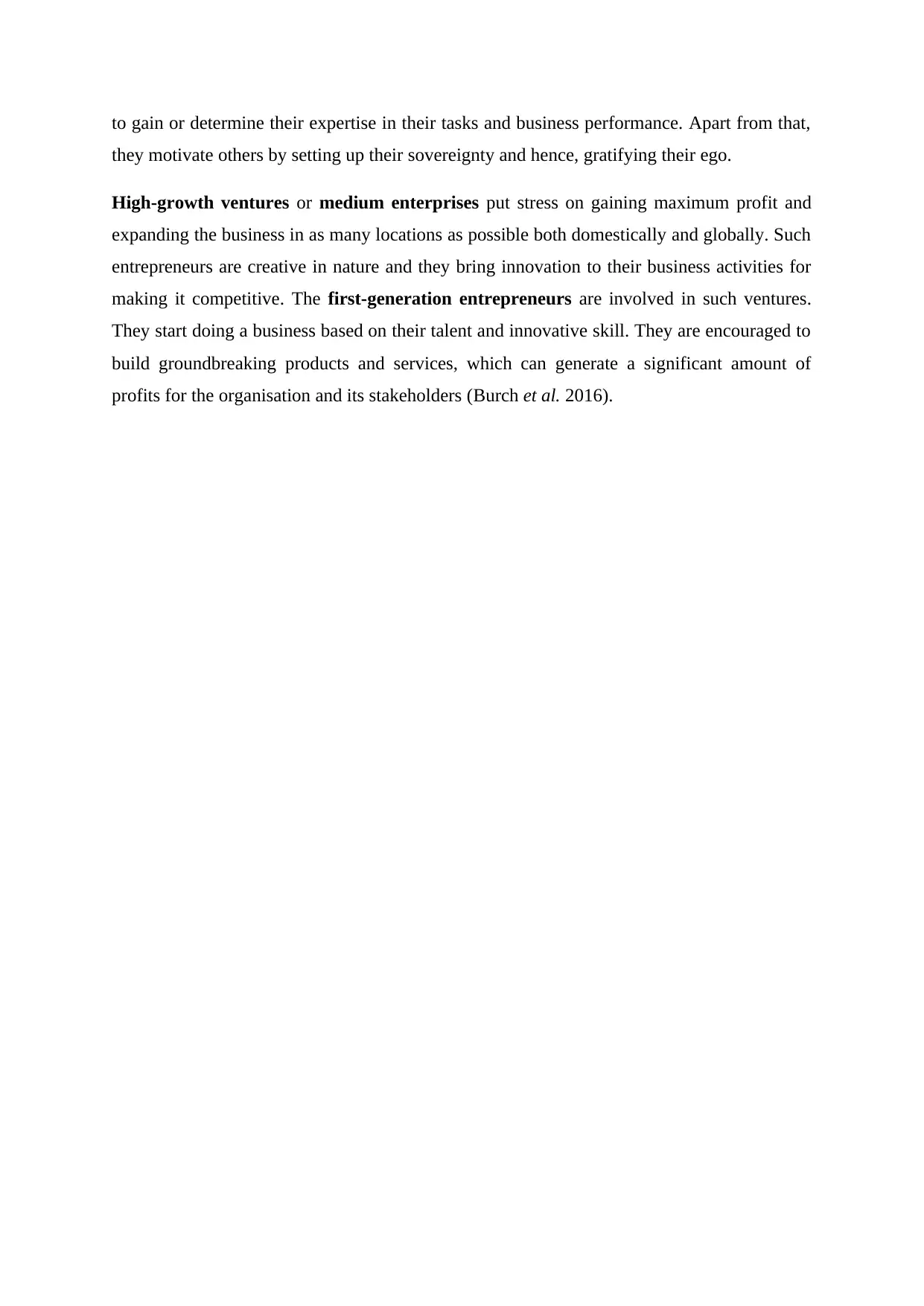
to gain or determine their expertise in their tasks and business performance. Apart from that,
they motivate others by setting up their sovereignty and hence, gratifying their ego.
High-growth ventures or medium enterprises put stress on gaining maximum profit and
expanding the business in as many locations as possible both domestically and globally. Such
entrepreneurs are creative in nature and they bring innovation to their business activities for
making it competitive. The first-generation entrepreneurs are involved in such ventures.
They start doing a business based on their talent and innovative skill. They are encouraged to
build groundbreaking products and services, which can generate a significant amount of
profits for the organisation and its stakeholders (Burch et al. 2016).
they motivate others by setting up their sovereignty and hence, gratifying their ego.
High-growth ventures or medium enterprises put stress on gaining maximum profit and
expanding the business in as many locations as possible both domestically and globally. Such
entrepreneurs are creative in nature and they bring innovation to their business activities for
making it competitive. The first-generation entrepreneurs are involved in such ventures.
They start doing a business based on their talent and innovative skill. They are encouraged to
build groundbreaking products and services, which can generate a significant amount of
profits for the organisation and its stakeholders (Burch et al. 2016).
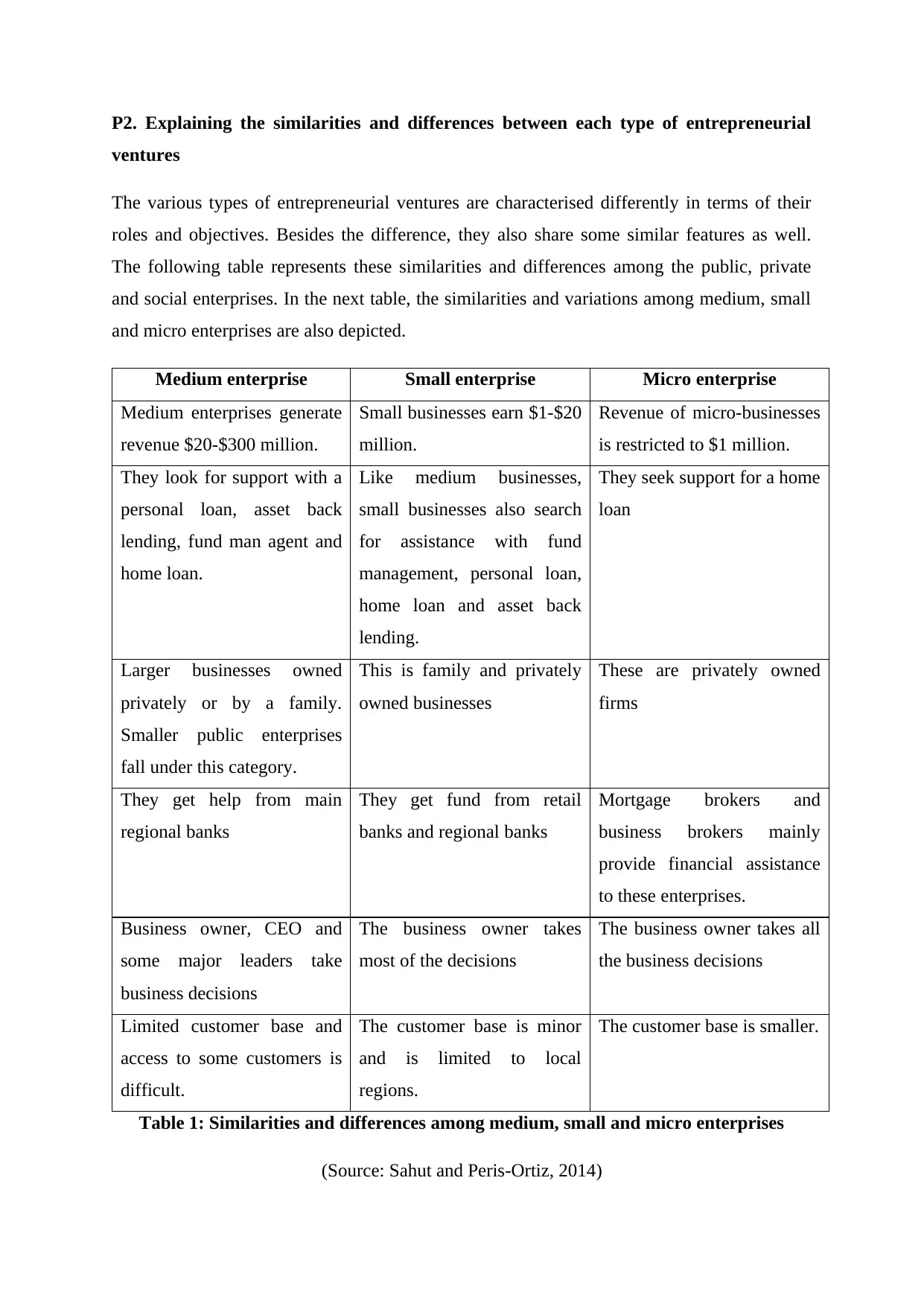
P2. Explaining the similarities and differences between each type of entrepreneurial
ventures
The various types of entrepreneurial ventures are characterised differently in terms of their
roles and objectives. Besides the difference, they also share some similar features as well.
The following table represents these similarities and differences among the public, private
and social enterprises. In the next table, the similarities and variations among medium, small
and micro enterprises are also depicted.
Medium enterprise Small enterprise Micro enterprise
Medium enterprises generate
revenue $20-$300 million.
Small businesses earn $1-$20
million.
Revenue of micro-businesses
is restricted to $1 million.
They look for support with a
personal loan, asset back
lending, fund man agent and
home loan.
Like medium businesses,
small businesses also search
for assistance with fund
management, personal loan,
home loan and asset back
lending.
They seek support for a home
loan
Larger businesses owned
privately or by a family.
Smaller public enterprises
fall under this category.
This is family and privately
owned businesses
These are privately owned
firms
They get help from main
regional banks
They get fund from retail
banks and regional banks
Mortgage brokers and
business brokers mainly
provide financial assistance
to these enterprises.
Business owner, CEO and
some major leaders take
business decisions
The business owner takes
most of the decisions
The business owner takes all
the business decisions
Limited customer base and
access to some customers is
difficult.
The customer base is minor
and is limited to local
regions.
The customer base is smaller.
Table 1: Similarities and differences among medium, small and micro enterprises
(Source: Sahut and Peris-Ortiz, 2014)
ventures
The various types of entrepreneurial ventures are characterised differently in terms of their
roles and objectives. Besides the difference, they also share some similar features as well.
The following table represents these similarities and differences among the public, private
and social enterprises. In the next table, the similarities and variations among medium, small
and micro enterprises are also depicted.
Medium enterprise Small enterprise Micro enterprise
Medium enterprises generate
revenue $20-$300 million.
Small businesses earn $1-$20
million.
Revenue of micro-businesses
is restricted to $1 million.
They look for support with a
personal loan, asset back
lending, fund man agent and
home loan.
Like medium businesses,
small businesses also search
for assistance with fund
management, personal loan,
home loan and asset back
lending.
They seek support for a home
loan
Larger businesses owned
privately or by a family.
Smaller public enterprises
fall under this category.
This is family and privately
owned businesses
These are privately owned
firms
They get help from main
regional banks
They get fund from retail
banks and regional banks
Mortgage brokers and
business brokers mainly
provide financial assistance
to these enterprises.
Business owner, CEO and
some major leaders take
business decisions
The business owner takes
most of the decisions
The business owner takes all
the business decisions
Limited customer base and
access to some customers is
difficult.
The customer base is minor
and is limited to local
regions.
The customer base is smaller.
Table 1: Similarities and differences among medium, small and micro enterprises
(Source: Sahut and Peris-Ortiz, 2014)
⊘ This is a preview!⊘
Do you want full access?
Subscribe today to unlock all pages.

Trusted by 1+ million students worldwide
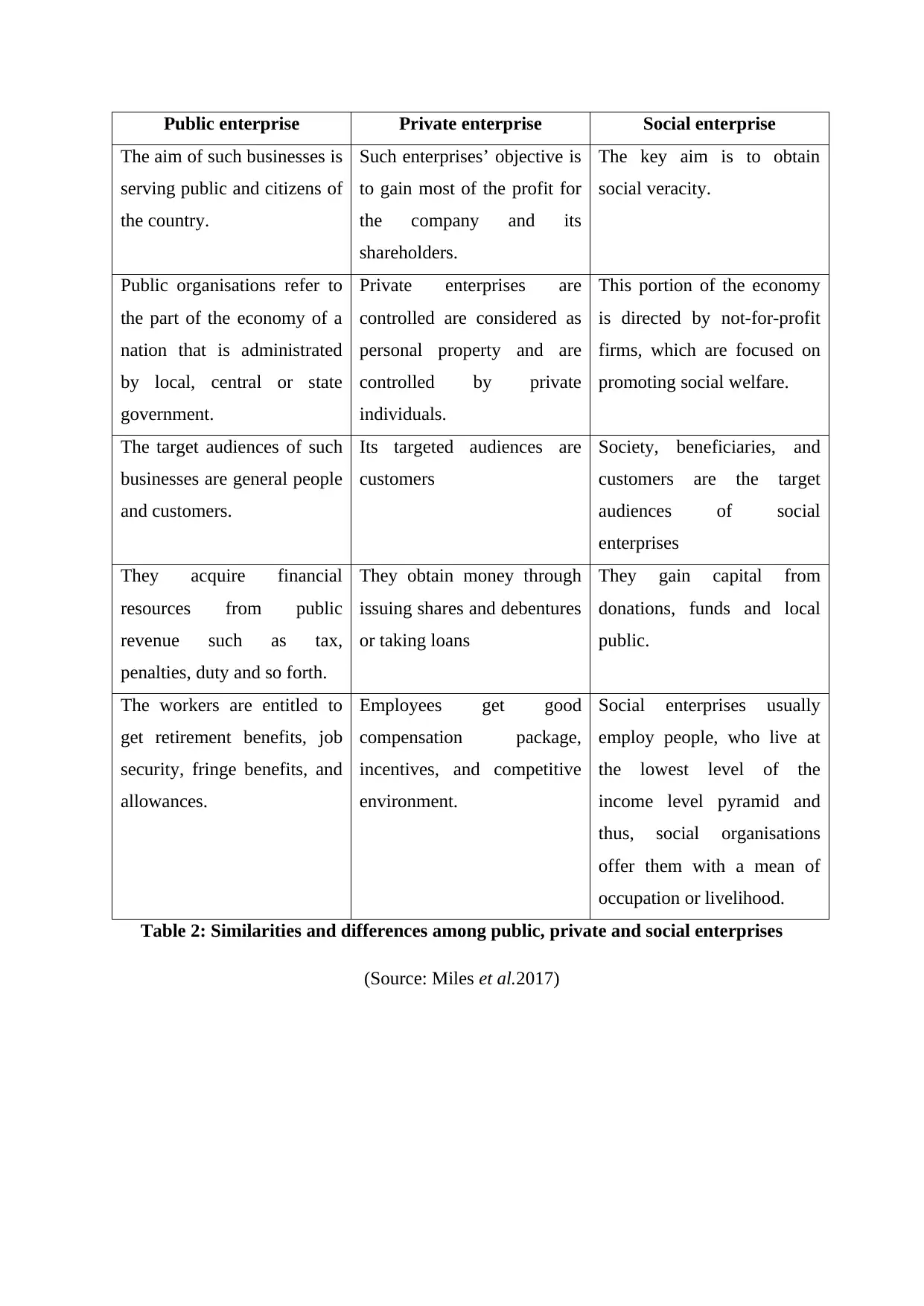
Public enterprise Private enterprise Social enterprise
The aim of such businesses is
serving public and citizens of
the country.
Such enterprises’ objective is
to gain most of the profit for
the company and its
shareholders.
The key aim is to obtain
social veracity.
Public organisations refer to
the part of the economy of a
nation that is administrated
by local, central or state
government.
Private enterprises are
controlled are considered as
personal property and are
controlled by private
individuals.
This portion of the economy
is directed by not-for-profit
firms, which are focused on
promoting social welfare.
The target audiences of such
businesses are general people
and customers.
Its targeted audiences are
customers
Society, beneficiaries, and
customers are the target
audiences of social
enterprises
They acquire financial
resources from public
revenue such as tax,
penalties, duty and so forth.
They obtain money through
issuing shares and debentures
or taking loans
They gain capital from
donations, funds and local
public.
The workers are entitled to
get retirement benefits, job
security, fringe benefits, and
allowances.
Employees get good
compensation package,
incentives, and competitive
environment.
Social enterprises usually
employ people, who live at
the lowest level of the
income level pyramid and
thus, social organisations
offer them with a mean of
occupation or livelihood.
Table 2: Similarities and differences among public, private and social enterprises
(Source: Miles et al.2017)
The aim of such businesses is
serving public and citizens of
the country.
Such enterprises’ objective is
to gain most of the profit for
the company and its
shareholders.
The key aim is to obtain
social veracity.
Public organisations refer to
the part of the economy of a
nation that is administrated
by local, central or state
government.
Private enterprises are
controlled are considered as
personal property and are
controlled by private
individuals.
This portion of the economy
is directed by not-for-profit
firms, which are focused on
promoting social welfare.
The target audiences of such
businesses are general people
and customers.
Its targeted audiences are
customers
Society, beneficiaries, and
customers are the target
audiences of social
enterprises
They acquire financial
resources from public
revenue such as tax,
penalties, duty and so forth.
They obtain money through
issuing shares and debentures
or taking loans
They gain capital from
donations, funds and local
public.
The workers are entitled to
get retirement benefits, job
security, fringe benefits, and
allowances.
Employees get good
compensation package,
incentives, and competitive
environment.
Social enterprises usually
employ people, who live at
the lowest level of the
income level pyramid and
thus, social organisations
offer them with a mean of
occupation or livelihood.
Table 2: Similarities and differences among public, private and social enterprises
(Source: Miles et al.2017)
Paraphrase This Document
Need a fresh take? Get an instant paraphrase of this document with our AI Paraphraser
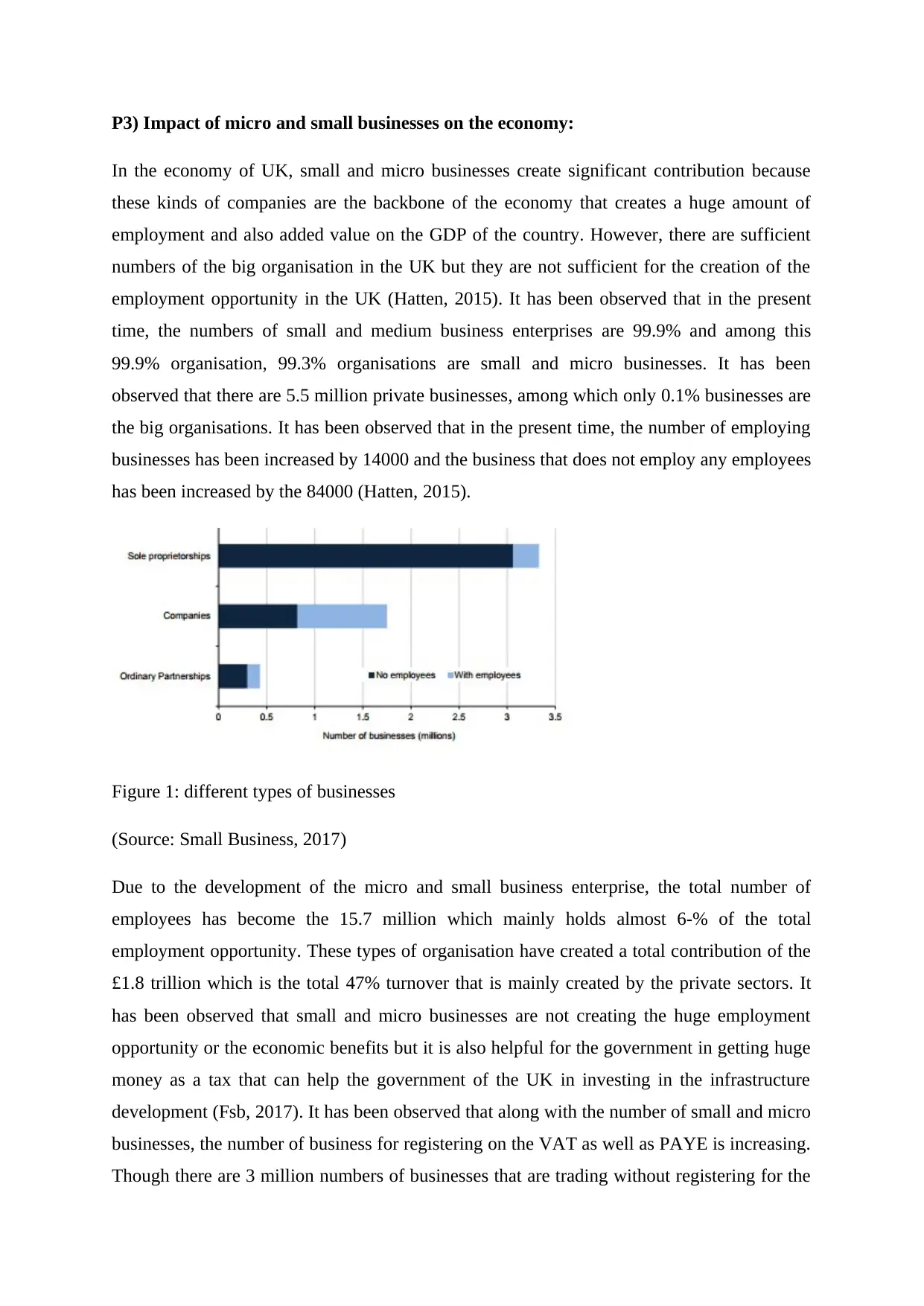
P3) Impact of micro and small businesses on the economy:
In the economy of UK, small and micro businesses create significant contribution because
these kinds of companies are the backbone of the economy that creates a huge amount of
employment and also added value on the GDP of the country. However, there are sufficient
numbers of the big organisation in the UK but they are not sufficient for the creation of the
employment opportunity in the UK (Hatten, 2015). It has been observed that in the present
time, the numbers of small and medium business enterprises are 99.9% and among this
99.9% organisation, 99.3% organisations are small and micro businesses. It has been
observed that there are 5.5 million private businesses, among which only 0.1% businesses are
the big organisations. It has been observed that in the present time, the number of employing
businesses has been increased by 14000 and the business that does not employ any employees
has been increased by the 84000 (Hatten, 2015).
Figure 1: different types of businesses
(Source: Small Business, 2017)
Due to the development of the micro and small business enterprise, the total number of
employees has become the 15.7 million which mainly holds almost 6-% of the total
employment opportunity. These types of organisation have created a total contribution of the
£1.8 trillion which is the total 47% turnover that is mainly created by the private sectors. It
has been observed that small and micro businesses are not creating the huge employment
opportunity or the economic benefits but it is also helpful for the government in getting huge
money as a tax that can help the government of the UK in investing in the infrastructure
development (Fsb, 2017). It has been observed that along with the number of small and micro
businesses, the number of business for registering on the VAT as well as PAYE is increasing.
Though there are 3 million numbers of businesses that are trading without registering for the
In the economy of UK, small and micro businesses create significant contribution because
these kinds of companies are the backbone of the economy that creates a huge amount of
employment and also added value on the GDP of the country. However, there are sufficient
numbers of the big organisation in the UK but they are not sufficient for the creation of the
employment opportunity in the UK (Hatten, 2015). It has been observed that in the present
time, the numbers of small and medium business enterprises are 99.9% and among this
99.9% organisation, 99.3% organisations are small and micro businesses. It has been
observed that there are 5.5 million private businesses, among which only 0.1% businesses are
the big organisations. It has been observed that in the present time, the number of employing
businesses has been increased by 14000 and the business that does not employ any employees
has been increased by the 84000 (Hatten, 2015).
Figure 1: different types of businesses
(Source: Small Business, 2017)
Due to the development of the micro and small business enterprise, the total number of
employees has become the 15.7 million which mainly holds almost 6-% of the total
employment opportunity. These types of organisation have created a total contribution of the
£1.8 trillion which is the total 47% turnover that is mainly created by the private sectors. It
has been observed that small and micro businesses are not creating the huge employment
opportunity or the economic benefits but it is also helpful for the government in getting huge
money as a tax that can help the government of the UK in investing in the infrastructure
development (Fsb, 2017). It has been observed that along with the number of small and micro
businesses, the number of business for registering on the VAT as well as PAYE is increasing.
Though there are 3 million numbers of businesses that are trading without registering for the
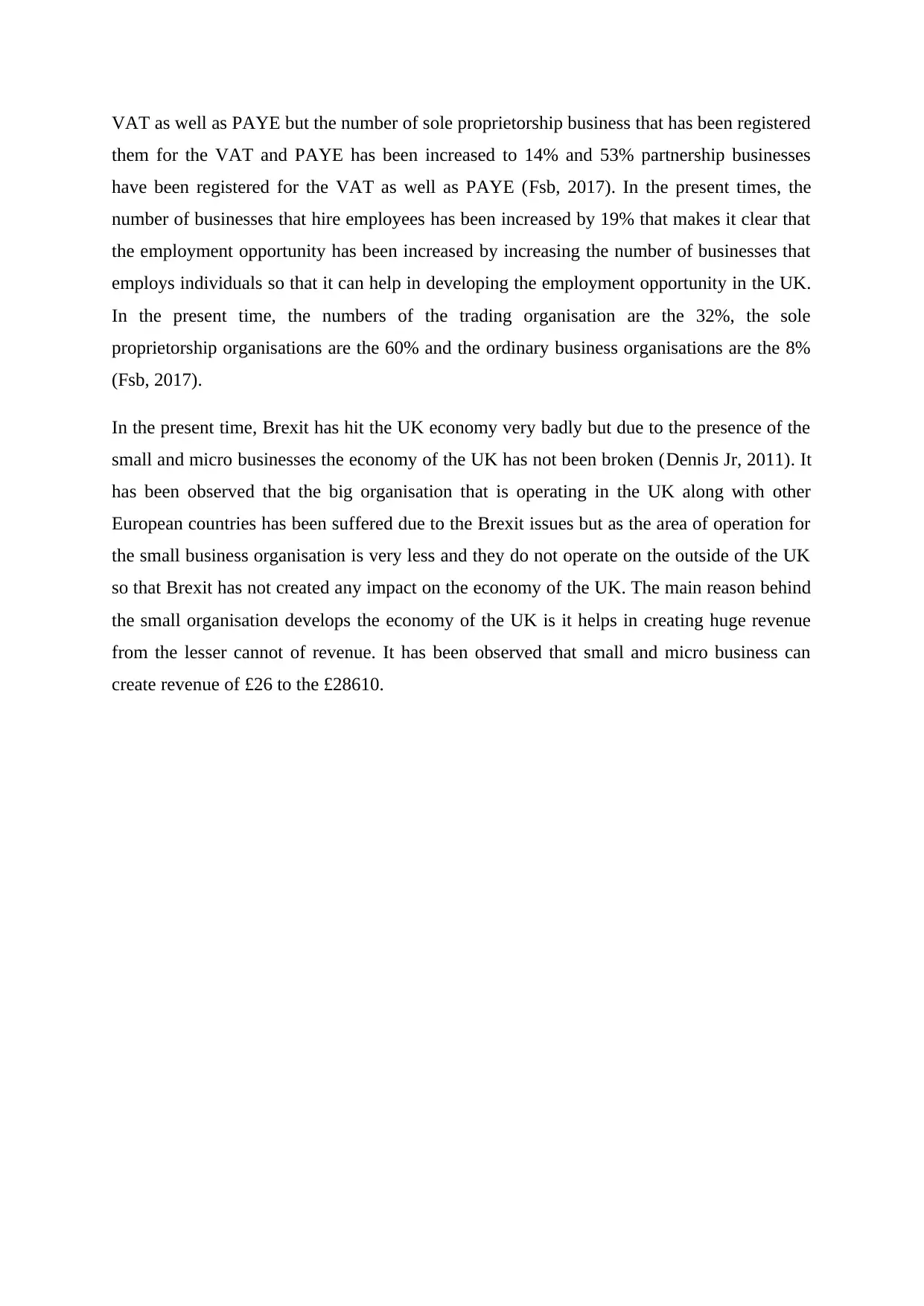
VAT as well as PAYE but the number of sole proprietorship business that has been registered
them for the VAT and PAYE has been increased to 14% and 53% partnership businesses
have been registered for the VAT as well as PAYE (Fsb, 2017). In the present times, the
number of businesses that hire employees has been increased by 19% that makes it clear that
the employment opportunity has been increased by increasing the number of businesses that
employs individuals so that it can help in developing the employment opportunity in the UK.
In the present time, the numbers of the trading organisation are the 32%, the sole
proprietorship organisations are the 60% and the ordinary business organisations are the 8%
(Fsb, 2017).
In the present time, Brexit has hit the UK economy very badly but due to the presence of the
small and micro businesses the economy of the UK has not been broken (Dennis Jr, 2011). It
has been observed that the big organisation that is operating in the UK along with other
European countries has been suffered due to the Brexit issues but as the area of operation for
the small business organisation is very less and they do not operate on the outside of the UK
so that Brexit has not created any impact on the economy of the UK. The main reason behind
the small organisation develops the economy of the UK is it helps in creating huge revenue
from the lesser cannot of revenue. It has been observed that small and micro business can
create revenue of £26 to the £28610.
them for the VAT and PAYE has been increased to 14% and 53% partnership businesses
have been registered for the VAT as well as PAYE (Fsb, 2017). In the present times, the
number of businesses that hire employees has been increased by 19% that makes it clear that
the employment opportunity has been increased by increasing the number of businesses that
employs individuals so that it can help in developing the employment opportunity in the UK.
In the present time, the numbers of the trading organisation are the 32%, the sole
proprietorship organisations are the 60% and the ordinary business organisations are the 8%
(Fsb, 2017).
In the present time, Brexit has hit the UK economy very badly but due to the presence of the
small and micro businesses the economy of the UK has not been broken (Dennis Jr, 2011). It
has been observed that the big organisation that is operating in the UK along with other
European countries has been suffered due to the Brexit issues but as the area of operation for
the small business organisation is very less and they do not operate on the outside of the UK
so that Brexit has not created any impact on the economy of the UK. The main reason behind
the small organisation develops the economy of the UK is it helps in creating huge revenue
from the lesser cannot of revenue. It has been observed that small and micro business can
create revenue of £26 to the £28610.
⊘ This is a preview!⊘
Do you want full access?
Subscribe today to unlock all pages.

Trusted by 1+ million students worldwide
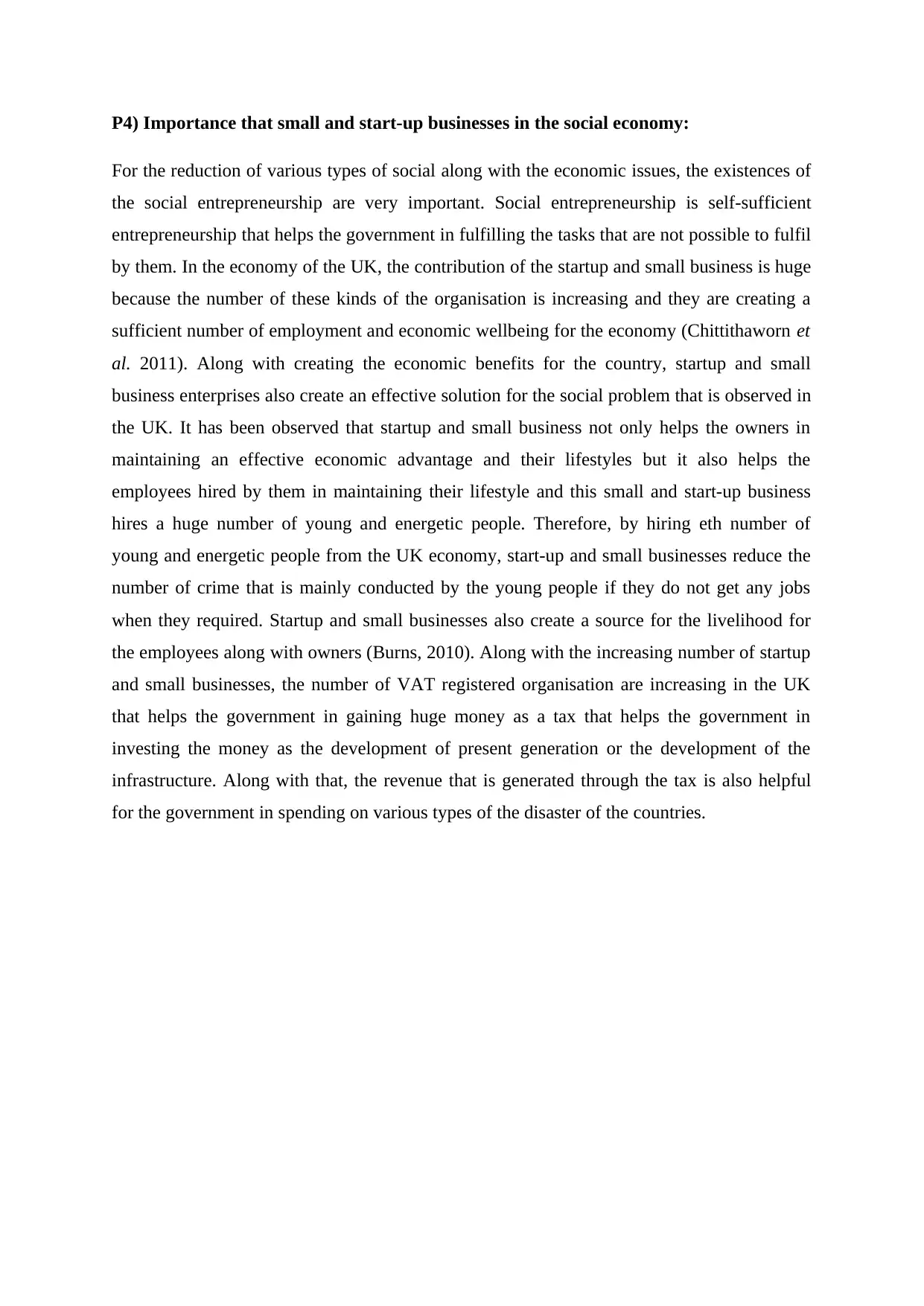
P4) Importance that small and start-up businesses in the social economy:
For the reduction of various types of social along with the economic issues, the existences of
the social entrepreneurship are very important. Social entrepreneurship is self-sufficient
entrepreneurship that helps the government in fulfilling the tasks that are not possible to fulfil
by them. In the economy of the UK, the contribution of the startup and small business is huge
because the number of these kinds of the organisation is increasing and they are creating a
sufficient number of employment and economic wellbeing for the economy (Chittithaworn et
al. 2011). Along with creating the economic benefits for the country, startup and small
business enterprises also create an effective solution for the social problem that is observed in
the UK. It has been observed that startup and small business not only helps the owners in
maintaining an effective economic advantage and their lifestyles but it also helps the
employees hired by them in maintaining their lifestyle and this small and start-up business
hires a huge number of young and energetic people. Therefore, by hiring eth number of
young and energetic people from the UK economy, start-up and small businesses reduce the
number of crime that is mainly conducted by the young people if they do not get any jobs
when they required. Startup and small businesses also create a source for the livelihood for
the employees along with owners (Burns, 2010). Along with the increasing number of startup
and small businesses, the number of VAT registered organisation are increasing in the UK
that helps the government in gaining huge money as a tax that helps the government in
investing the money as the development of present generation or the development of the
infrastructure. Along with that, the revenue that is generated through the tax is also helpful
for the government in spending on various types of the disaster of the countries.
For the reduction of various types of social along with the economic issues, the existences of
the social entrepreneurship are very important. Social entrepreneurship is self-sufficient
entrepreneurship that helps the government in fulfilling the tasks that are not possible to fulfil
by them. In the economy of the UK, the contribution of the startup and small business is huge
because the number of these kinds of the organisation is increasing and they are creating a
sufficient number of employment and economic wellbeing for the economy (Chittithaworn et
al. 2011). Along with creating the economic benefits for the country, startup and small
business enterprises also create an effective solution for the social problem that is observed in
the UK. It has been observed that startup and small business not only helps the owners in
maintaining an effective economic advantage and their lifestyles but it also helps the
employees hired by them in maintaining their lifestyle and this small and start-up business
hires a huge number of young and energetic people. Therefore, by hiring eth number of
young and energetic people from the UK economy, start-up and small businesses reduce the
number of crime that is mainly conducted by the young people if they do not get any jobs
when they required. Startup and small businesses also create a source for the livelihood for
the employees along with owners (Burns, 2010). Along with the increasing number of startup
and small businesses, the number of VAT registered organisation are increasing in the UK
that helps the government in gaining huge money as a tax that helps the government in
investing the money as the development of present generation or the development of the
infrastructure. Along with that, the revenue that is generated through the tax is also helpful
for the government in spending on various types of the disaster of the countries.
Paraphrase This Document
Need a fresh take? Get an instant paraphrase of this document with our AI Paraphraser
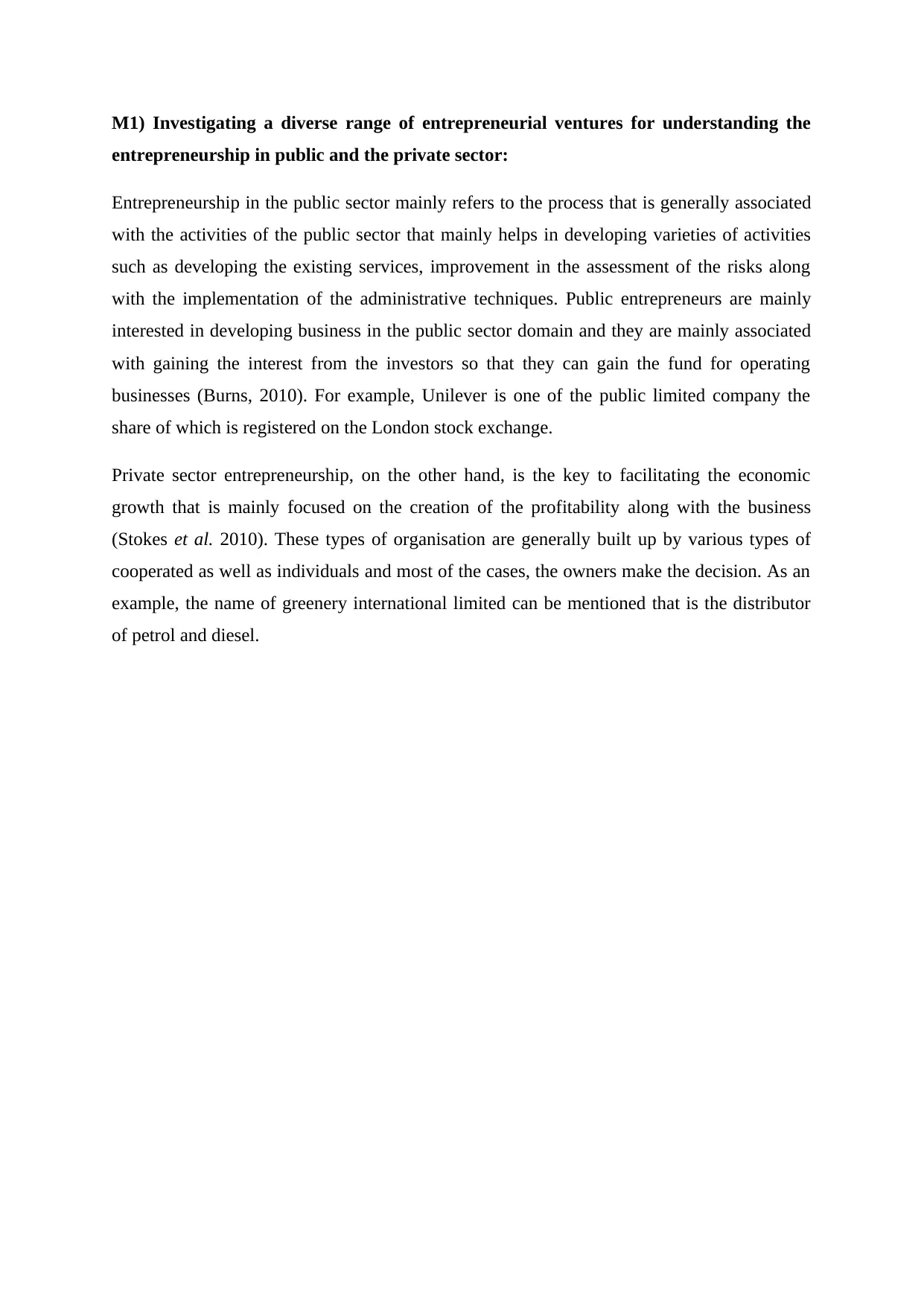
M1) Investigating a diverse range of entrepreneurial ventures for understanding the
entrepreneurship in public and the private sector:
Entrepreneurship in the public sector mainly refers to the process that is generally associated
with the activities of the public sector that mainly helps in developing varieties of activities
such as developing the existing services, improvement in the assessment of the risks along
with the implementation of the administrative techniques. Public entrepreneurs are mainly
interested in developing business in the public sector domain and they are mainly associated
with gaining the interest from the investors so that they can gain the fund for operating
businesses (Burns, 2010). For example, Unilever is one of the public limited company the
share of which is registered on the London stock exchange.
Private sector entrepreneurship, on the other hand, is the key to facilitating the economic
growth that is mainly focused on the creation of the profitability along with the business
(Stokes et al. 2010). These types of organisation are generally built up by various types of
cooperated as well as individuals and most of the cases, the owners make the decision. As an
example, the name of greenery international limited can be mentioned that is the distributor
of petrol and diesel.
entrepreneurship in public and the private sector:
Entrepreneurship in the public sector mainly refers to the process that is generally associated
with the activities of the public sector that mainly helps in developing varieties of activities
such as developing the existing services, improvement in the assessment of the risks along
with the implementation of the administrative techniques. Public entrepreneurs are mainly
interested in developing business in the public sector domain and they are mainly associated
with gaining the interest from the investors so that they can gain the fund for operating
businesses (Burns, 2010). For example, Unilever is one of the public limited company the
share of which is registered on the London stock exchange.
Private sector entrepreneurship, on the other hand, is the key to facilitating the economic
growth that is mainly focused on the creation of the profitability along with the business
(Stokes et al. 2010). These types of organisation are generally built up by various types of
cooperated as well as individuals and most of the cases, the owners make the decision. As an
example, the name of greenery international limited can be mentioned that is the distributor
of petrol and diesel.
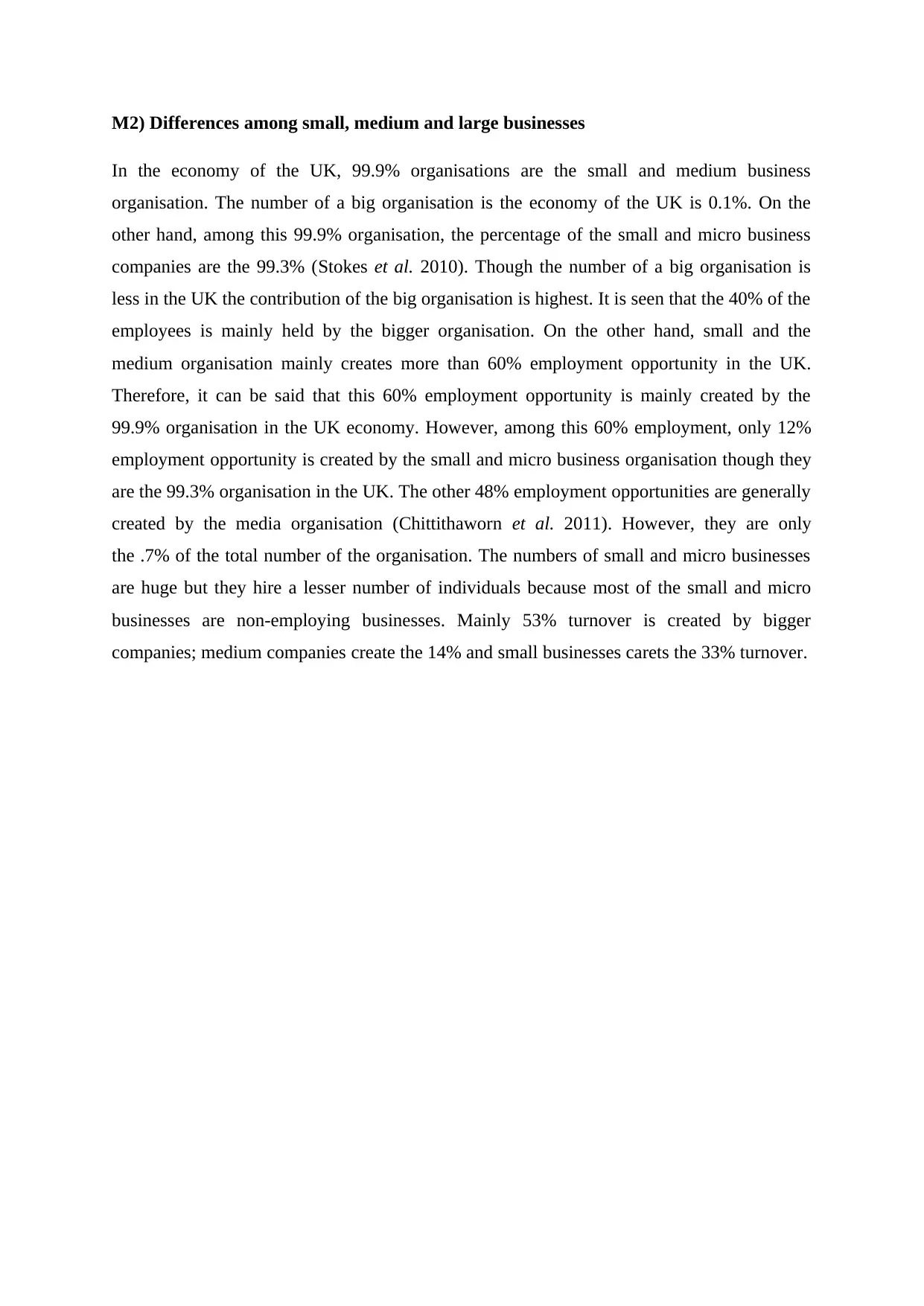
M2) Differences among small, medium and large businesses
In the economy of the UK, 99.9% organisations are the small and medium business
organisation. The number of a big organisation is the economy of the UK is 0.1%. On the
other hand, among this 99.9% organisation, the percentage of the small and micro business
companies are the 99.3% (Stokes et al. 2010). Though the number of a big organisation is
less in the UK the contribution of the big organisation is highest. It is seen that the 40% of the
employees is mainly held by the bigger organisation. On the other hand, small and the
medium organisation mainly creates more than 60% employment opportunity in the UK.
Therefore, it can be said that this 60% employment opportunity is mainly created by the
99.9% organisation in the UK economy. However, among this 60% employment, only 12%
employment opportunity is created by the small and micro business organisation though they
are the 99.3% organisation in the UK. The other 48% employment opportunities are generally
created by the media organisation (Chittithaworn et al. 2011). However, they are only
the .7% of the total number of the organisation. The numbers of small and micro businesses
are huge but they hire a lesser number of individuals because most of the small and micro
businesses are non-employing businesses. Mainly 53% turnover is created by bigger
companies; medium companies create the 14% and small businesses carets the 33% turnover.
In the economy of the UK, 99.9% organisations are the small and medium business
organisation. The number of a big organisation is the economy of the UK is 0.1%. On the
other hand, among this 99.9% organisation, the percentage of the small and micro business
companies are the 99.3% (Stokes et al. 2010). Though the number of a big organisation is
less in the UK the contribution of the big organisation is highest. It is seen that the 40% of the
employees is mainly held by the bigger organisation. On the other hand, small and the
medium organisation mainly creates more than 60% employment opportunity in the UK.
Therefore, it can be said that this 60% employment opportunity is mainly created by the
99.9% organisation in the UK economy. However, among this 60% employment, only 12%
employment opportunity is created by the small and micro business organisation though they
are the 99.3% organisation in the UK. The other 48% employment opportunities are generally
created by the media organisation (Chittithaworn et al. 2011). However, they are only
the .7% of the total number of the organisation. The numbers of small and micro businesses
are huge but they hire a lesser number of individuals because most of the small and micro
businesses are non-employing businesses. Mainly 53% turnover is created by bigger
companies; medium companies create the 14% and small businesses carets the 33% turnover.
⊘ This is a preview!⊘
Do you want full access?
Subscribe today to unlock all pages.

Trusted by 1+ million students worldwide
1 out of 20
Related Documents
Your All-in-One AI-Powered Toolkit for Academic Success.
+13062052269
info@desklib.com
Available 24*7 on WhatsApp / Email
![[object Object]](/_next/static/media/star-bottom.7253800d.svg)
Unlock your academic potential
Copyright © 2020–2025 A2Z Services. All Rights Reserved. Developed and managed by ZUCOL.




